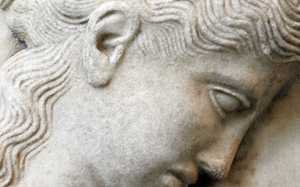Style conscious
By Rose Schapiro, AB’09
Image courtesy Richard Neer
Greek gods are not necessarily famous for their togas. But to Richard Neer, the David B. and Clara E. Stern professor of art history, the way artists sculpted the fashions that clothed their marble idols reveals how the ancient Greeks saw their own connection to divinity—and how to think about style in art.
 The Elgin Marbles’ clunky, cramped poses—carved to fit the Parthenon’s friezes—convinced 19th-century British museum-goers that they must have been inferior Roman copies of classical Greek statues.
The Elgin Marbles’ clunky, cramped poses—carved to fit the Parthenon’s friezes—convinced 19th-century British museum-goers that they must have been inferior Roman copies of classical Greek statues.In art history, style is seen on the surface of the object. Sometimes it’s what strikes the viewer as odd or strange—the way color is used or a pose exaggerated. But style can also refer to the way clothes are carved out of marble, falling straight down a sculpture’s torso or clinging and draping on the figure’s legs. When he studies ancient art, Neer explains, he’s also analyzing “the overlooked ways that style, as a concept, plays in the production of hard facts in art history.”
According to Neer, how art historians see style raises issues of taste and judgment. Other than excavated pieces, he says, “we don’t have a whole lot of distinct secondary information” to explain how the art looked during the classical era. Instead, archaeologists and art historians assess the materials they find on digs, such as pottery shards and sculpture fragments. Based on those observations, experts determine when, and sometimes where, objects were crafted. “It’s strange,” Neer says, “how judgments that look to be idiosyncratic and nonverifiable acquire the status of judgments that are none of these things.” The phenomenon isn’t distinct to classical Greece. “There’s plenty of controversy about deciding which unsigned drawings count as drawings by Van Gogh.”
The judgments an audience makes based on aesthetic style can be unsound, Neer points out. When the Elgin Marbles, which once decorated the Parthenon, arrived at the British Museum in London in 1817, the public had a hard time believing they were actually Greek. The statues were too ugly and clunky, and several critics insisted they must be inferior Roman copies. But sure enough, the sculptures were Greek, and the cramped poses that made them perfect for the Parthenon’s friezes are an example of historical context illuminating artistic style.
Neer has written on classical Greek sculptures like the Elgin Marbles and on the political implications of vase-painting in ancient Greece. And although he focuses on a short pe-ri-od—300–600 BC—the ancient world’s issues of style and judgment inspire him to also veer into topics as varied as 17th-century French painting (which frequently borrowed classical motifs and poses) and Jean-Luc Godard’s experimental films.
For Neer, the ability to use his style insights across eras is an important part of the broad inquiry encouraged at Chicago. “I can’t think of anywhere else that a classical archaeologist would have been made welcome in cinema and media studies,” he explains.
Neer is at work on two books. The first, forthcoming from the University of Chicago Press, examines style and classical Greek sculpture, focusing on the 5th century BC, especially the high classical era (roughly 400–450 BC), when the Elgin Marbles were carved. “Form and content were really not separate for” the Greeks, he says. Many of the era’s sculptures feature a “quasi-see-through drapery,” clothes that hung heavily but also clung to the body, almost as if wet. In Nike Adjusting Her Sandal from the Temple of Nike, the drapery falls in dramatic folds between the statue’s stretching limbs, but also adheres to the leg itself. Neer argues that the style reflects a change in how Greeks saw themselves in relation to their gods, a “semivisibility” that made the deities somewhat obscured and yet accessible to the viewer.
Neer is also writing an introductory textbook (forthcoming from Thames & Hudson) covering almost 2,000 years of art in the ancient Mediterranean, the third millennium to the fourth century BC. It will also address ideas of style and methodological inquiry in ancient art. “I want to really show the affinity between art history and archaeology,” Neer explains. “I’ve decided the way to impact a field is to corrupt the young.”
Return to top